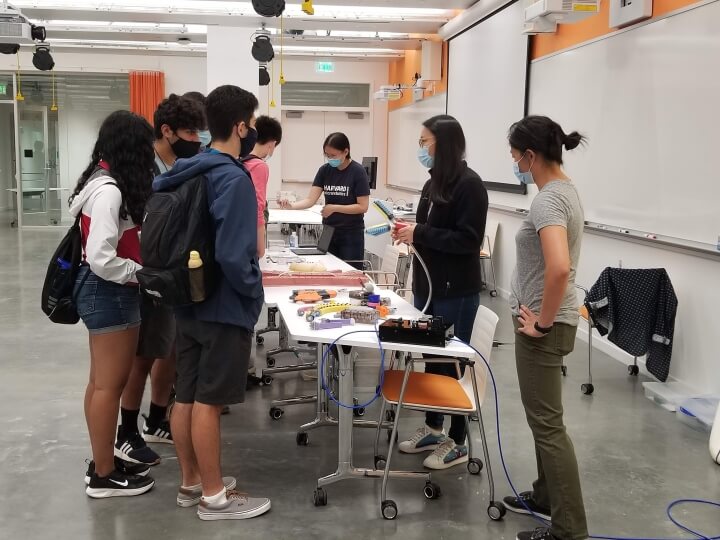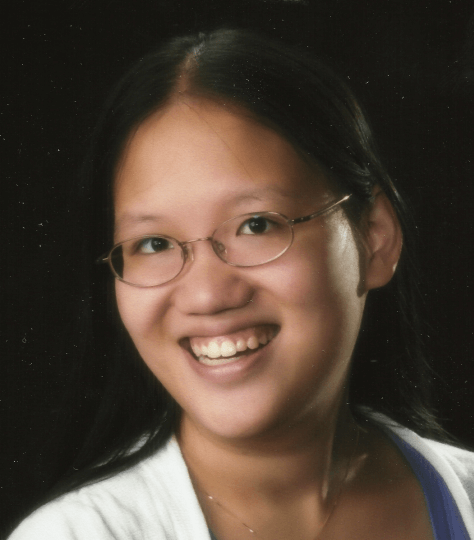Engineering is a step-by-step process, and Jennifer Shum loves every step of it. She loves the ideation, imagining a device that’s never existed before; and she loves the iteration of trying multiple designs until she finds one that works. She loves the tangible feeling of holding a new creation in her hand, and she loves thinking about putting it out in the world for others to enjoy.
Ph.D. candidate Jennifer Shum, center, works with teammates in the Harvard Microrobotics Lab. (Jennifer Shum)
That passion started with competitive robotics teams in high school, continued as she pursued a bachelor’s degree in mechanical engineering at Northeastern University, and now as a mechanical engineering and materials science Ph.D. candidate at the John A. Paulson School of Engineering and Applied Sciences (SEAS).
“To me, whether it’s art or robotics or design, it’s about building out new ideas that didn’t exist before,” said Shum, who is a member of the Harvard Microrobotics Lab. “That’s what excites me about all those spaces. You start with an idea, then you build a prototype or create an initial draft, then you iterate on it. You get to create these experiences or tools that didn’t exist before.”
Shum’s robotics work took her coast to coast even before she arrived at SEAS. In the span of just 18 months, she built test fixtures and 3D-printed components as an intern at iRobot, then went to Hologic and worked on a robotic surgical device as part of its engineering co-op.
Following her stints with the two Massachusetts-based companies, Shum spent six months in California in 2017 as an engineering undergraduate with the Mechanical Systems and Technology team at NASA’s Jet Propulsion Laboratory.
“As a robotics lover who wouldn’t love that?” she said. “I worked with a giant environmental chamber, and we tested things at different pressures and temperatures to simulate drilling into the rocks on Mars. We simulated environmental conditions and tested out the corer design that eventually got to be on Perseverance, which was insanely cool.”
Projects like those taught Shum just how far-reaching the impacts of robotics can be. She also knows robotics can be beneficial in much smaller ways; as a senior capstone project designed an automated cake-decorator.
“We can use robotics to help people in the medical field, or we can do new things and explore space, or we can just have fun and use it to improve our daily lives,” she said.
Engineering is a technical field, but aesthetics and visual design can play a key part. Shum has always cared about both, pursuing numerous artistic side projects throughout her journey as a mechanical engineer. She’s designed multiple contest-winning T-shirts, including the one given to all 2018 summer interns at JPL.
She’s also programmed several computer games over the years, and written two books: a coloring book, and a children’s story called “The Cookie Catastrophe” that she wrote, illustrated and published during the summer after high school graduation.
“I just tackled it page by page,” she said. “You start with an idea, then you play with it. You take a first pass, and then you try to iterate and improve on it. Whether that’s changing the art around or changing text in a children’s book, or you’re testing with a robotic sensor and running lab scripts, it’s all data and getting to know where you want to take a design.”
Jennifer Shum is a Ph.D. candidate in mechanical engineering and materials science working in the Harvard Microrobotics Lab at SEAS. (Jennifer Shum)
As her undergraduate studies drew to a close in the spring of 2018, Shum wasn’t sure what professional path to take. She looked at multiple labs with different focuses for a potential graduate degree and considered going into industry. The Microrobotics Lab, led by Robert Wood, Harry Lewis and Marlyn McGrath Professor of Engineering and Applied Sciences, ended up speaking to all of her interests.
“I got to build actual, tangible things,” she said. “It was very interdisciplinary, whether it was biology, or different types of engineering like mechanical, electrical and computer science. For any grad student, what you care about the most is the community you’re stepping into. Professor Wood is great and very supportive of students, and the whole lab feels like a community, family and home – somewhere you can chill and play ping-pong, or ask really hard, technical questions.”
The Microrobotics Lab also tapped into Shum’s interest in biology. She’d considered majoring in biology as an undergraduate but building something and seeing it in action ultimately drew her to mechanical engineering.
“I loved how things work in biology, how there’s a story of how things interconnect,” she said. “We use a lot of bio-inspiration for the robots in our lab, but it has a really core fabrication and manufacturing element, which I really love having in the robotics space.”
Shum isn’t sure if she’ll write another book someday. If she does, she hopes to make it about robotics, hopefully to inspire more children to enter STEM fields. For now, she’s fully immersed in the step-by-step design, iteration and fabrication of her work at SEAS.
“I’ve really enjoyed getting to meet lots of people working on lots of different things and hear lots of different ideas,” Shum said. “I get to work on cool things, but also be inspired by looking around and seeing the things that other people are doing. But more than that, I’ve been able to really find community here. I’ve found so many different people in different areas of my life that I can grow with that support me and make this experience worthwhile.”

